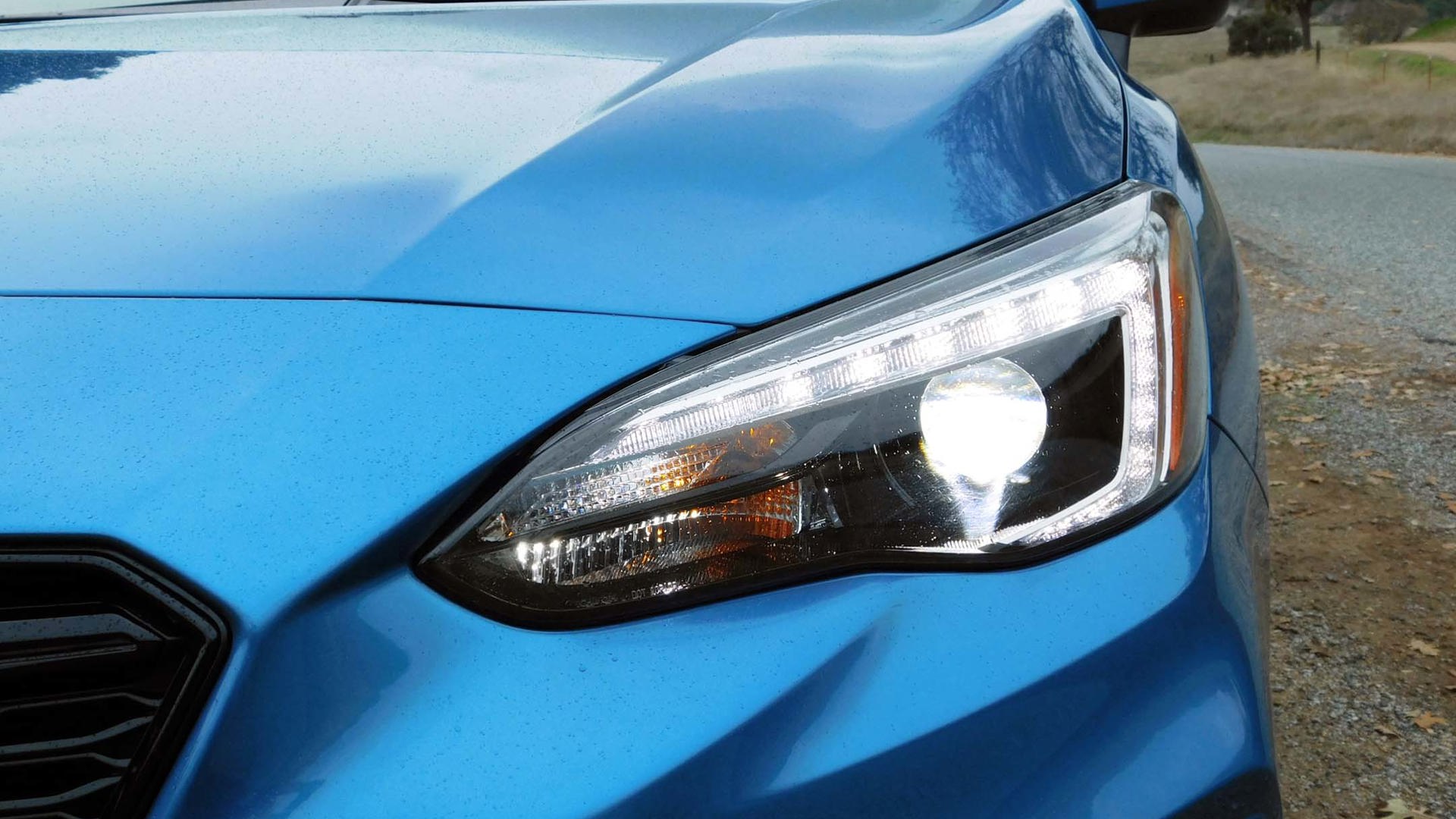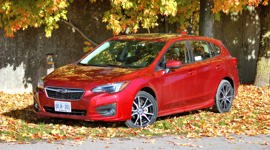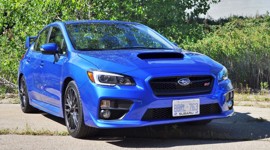Monterey, California – The back roads surrounding this historic port city are a driver’s delight. Scenic and twisting, they wind through dense forests, over mountainous ridges, and up to picturesque vineyards. They’re not especially smooth though, and as I carved through a particularly deep mid-curve bump along Carmel Valley Road it occurred to me that Subaru may have deliberately chosen some of the roughest segments for the introduction of its all-new 2017 Impreza.
On the road, the new platform’s increased rigidity and improved suspension geometry translate into impressively unflappable handling and ride quality.
It would make sense, because what better way to show off the Impreza’s new Global Subaru Platform? The scalable modular platform makes its debut on the Impreza (which will now be built in Indiana, USA) and it will soon be underpinning most of Subaru’s lineup, including an upcoming new three-row crossover. The platform features increased use of high-tensile steel, advanced new welding processes, new use of structural adhesives, and carefully optimized design, all aimed at achieving a 70 percent improvement in torsional rigidity, reduced NVH (noise, vibration and harshness), and a 40 percent stronger structure.
The improved structure provides outstanding performance in the challenging new small offset and oblique crash tests, and while the 2017 Impreza has yet to undergo official North American testing, Subaru’s own internal testing indicates that the car should achieve top scores across the board.
New structure equals new refinement
On the road, the new platform’s increased rigidity and improved suspension geometry translate into impressively unflappable handling and ride quality: The Impreza soaks up bumps with quiet composure and absolutely no discernible body flex, allowing the well-tuned suspension to deliver stable, flat, confidence-inspiring handling regardless of the condition of the road. The steering ratio has been quickened up (from 16:1 in the previous car to 13:1 in the new model, same as the BRZ coupe), and this gives the Impreza an eagerly responsive character in the corners. On range-topping Sport-Tech models like my hatchback tester, an active torque-vectoring system helps maximize grip and balance, reducing the tendency towards understeer and making the Impreza a real treat to drive during a short autocross exercise Subaru set up for us. Sport-Tech models also get 18-inch wheels, an Impreza first.
Power for the 2017 Impreza comes from an updated version of Subaru’s 2.0L four-cylinder boxer engine, which now gets direct injection for improved performance and fuel economy, and features revised internals for reduced weight and NVH. Output, at 152 hp and 145 lb-ft of torque, is up fractionally over the previous engine’s 148 hp. Transmission choices include either a 5-speed manual (available on all but the top-end Sport-Tech trim) or a CVT automatic, both of which feed power to all four wheels via Subaru’s Symmetrical AWD system.
Standard full-time all-wheel drive still the key drivetrain advantage
For 2017 the CVT has been revised to produce a wider range of ratios, and it gets new step logic to produce seven programmed “gears” when operating in manual step mode. In automatic mode the wider ratios and revised tuning help the CVT keep the engine in the meat of its powerband with a minimum of droning, and in manual mode using the steering wheel paddle-shifters I was impressed with its crisp virtual shift action. Enthusiast drivers will likely want to opt for the manual transmission (and might therefore rue the fact it isn’t available in the top trim), but most buyers will be well served by the CVT – they’ll appreciate its fuel efficiency benefits and probably never notice any driving differences compared to a conventional automatic.
Fuel economy for the 2017 Impreza hatchback is rated at 8.4 / 6.5 L/100km (city/hwy), which is better than many of its front-wheel drive compact competitors. In real-world driving, on mostly back roads, I saw numbers ranging from a low of 7.7 L/100km to a high of 9.5 L/100km (this was following a spirited run up a canyon road, with a substantial altitude gain).
Stylistically the new Impreza doesn’t break any new ground, but instead it’s conservatively sleek and restrained in a way that should help increase mainstream appeal. Careful attention was paid to aerodynamics (the designers worked in a wind tunnel to optimize moulding details) and the new Impreza is a bit longer, lower and wider than the previous generation car, riding on a 25 mm longer wheelbase.
Majorly upgraded interior now on par with market leaders
Inside, this means the new Impreza is roomier than before, especially in terms of shoulder room and rear-seat legroom, and it’s also quieter than the outgoing model thanks to improved wind and road noise deadening. But what really stands out is the upscale new design and improved materials. Subaru has been justifiably criticized in the past for its plasticky, low-rent interiors and ho-hum electronics, but the new Impreza leaves all of that behind with an interior that compares well with segment leaders such as the Volkswagen Golf and Mazda3.
The design is modern and stylish, with a big 8.0-inch high-resolution touchscreen sitting front and centre in Sport and Sport-Tech models (lesser trims get a 6.5-inch screen). My Sport-Tech tester had perforated leather upholstery, a contrast-stitched leather-look dashboard and a tasteful smattering of brushed metallic trim, while a Sport sedan I drove later in the day featured cloth upholstery and faux carbon-fibre trim.
My tester also had the optional technology package (available on Sport and Sport-Tech models), which adds proximity entry with push-button start, high beam assist, reverse automatic braking, and Subaru’s Eyesight system which includes adaptive cruise control, lane-departure warning, lane-keep assist, pre-collision braking and pre-collision throttle management.
Infotainment fun, usually
The Harman infotainment system features standard Bluetooth connectivity, auxiliary input and USB input with MediaHub for iPod audio integration. Subaru’s Starlink smartphone integration (including Aha radio), Apple CarPlay and Android Auto functionality are also standard across all trim levels. Sport trim adds the 8-inch screen, CD player, dual USB inputs and an upgraded six-speaker audio system. Sport-Tech models further add a GPS navigation system, SMS text messaging capability and eight-speaker Harman Kardon audio system. I was impressed with the infotainment system’s lightning-quick responses and with the sound quality of the eight-speaker Harman Kardon audio, but I found some of the screen’s touchpoints too small (especially when trying to browse satellite radio stations) and the USB input didn’t play nicely with my older iPod Touch.
When I switched to a USB thumb drive I was happy to find that the system recognized all my various music file formats, but disappointed that it didn’t recognize my playlist folders, instead listing all 200+ songs in a single lump. There is a playlist icon in the system, so presumably it simply didn’t like the way I’d formatted things.
Minor infotainment incompatibilities aside, the 2017 Subaru Impreza hits a solid home-run. With the price escalator starting at $19,995 for the base Convenience sedan and running up to $21,895 for the Touring sedan, $24,395 for the Sport sedan and topping out at $30,995 for the Sport-Tech hatchback with Technology Package, the Impreza offers solid value in the compact segment, with the added benefit of standard all-wheel drive and segment-leading safety ratings.
The 2017 Impreza is on sale now, with the more potent WRX and STI derivatives expected in about a year.

















































